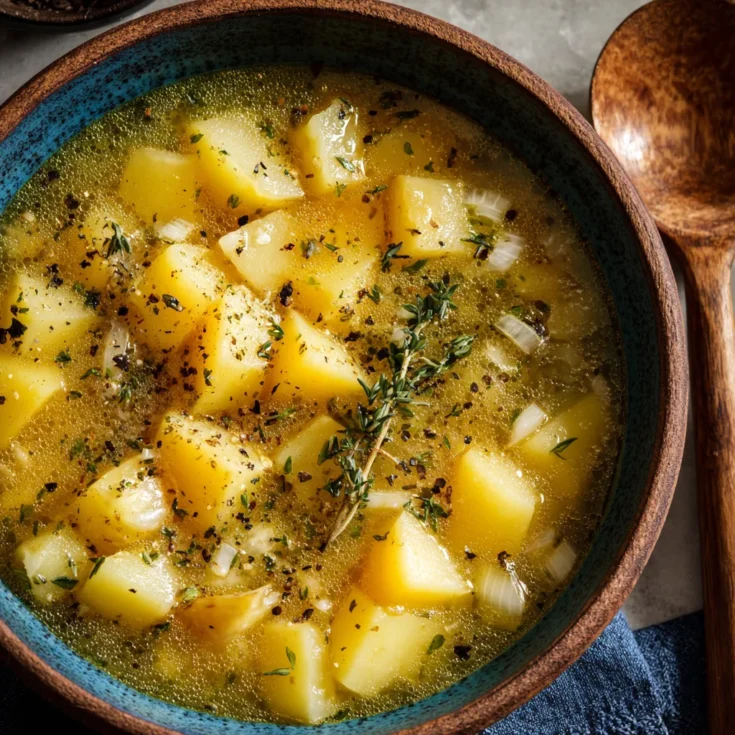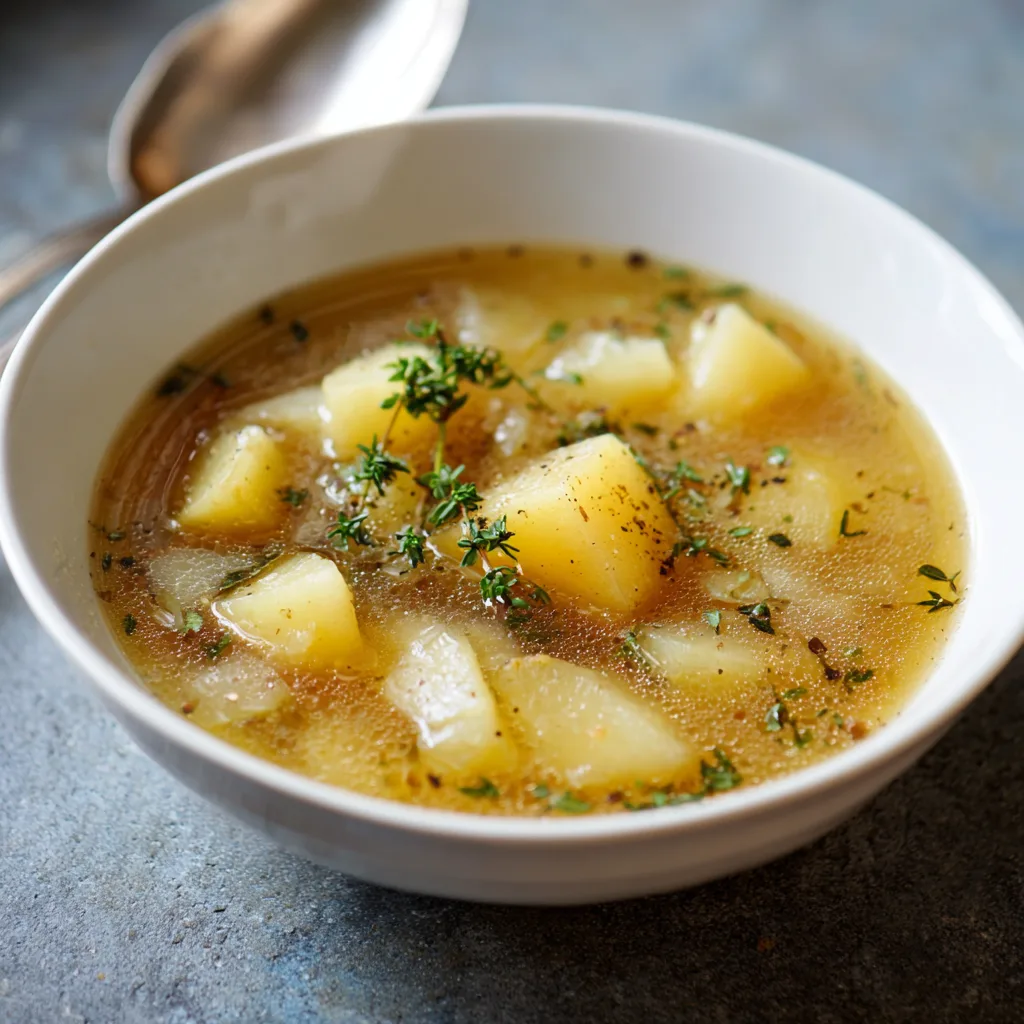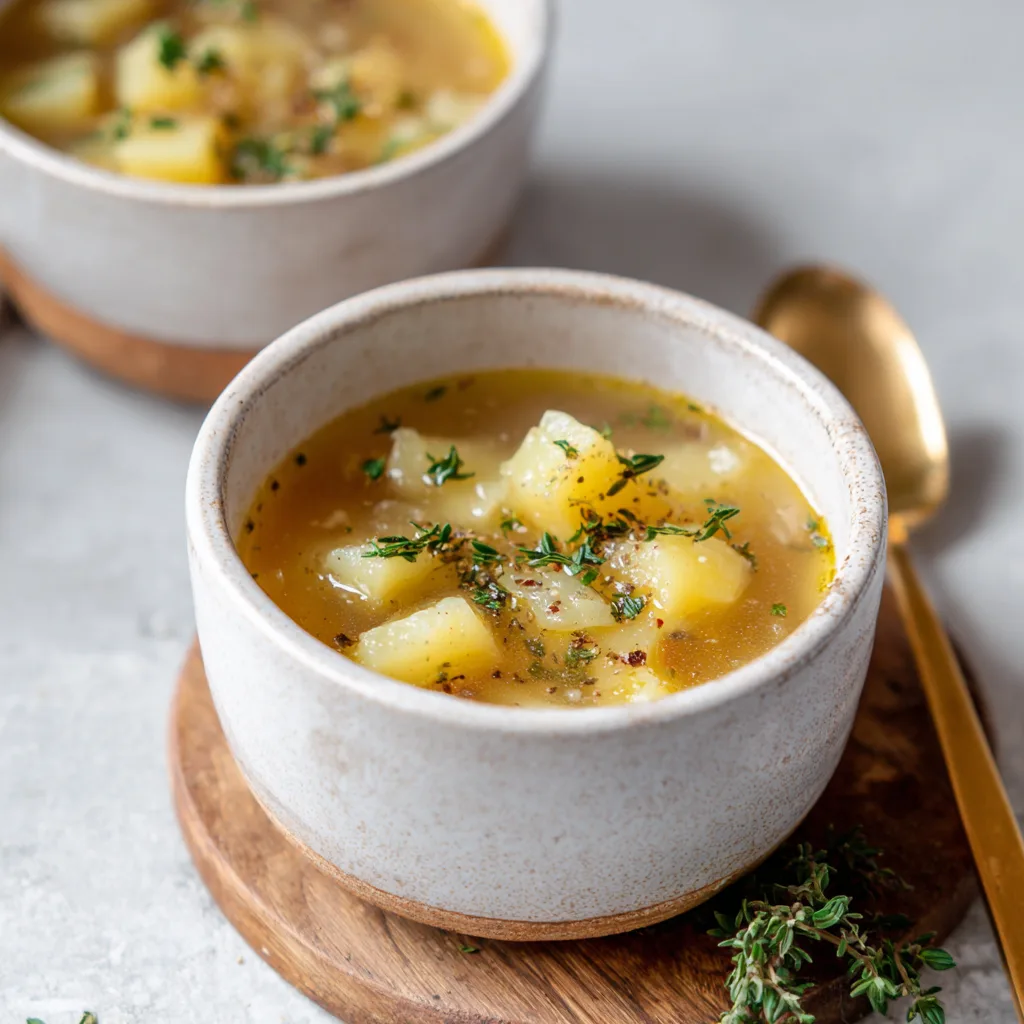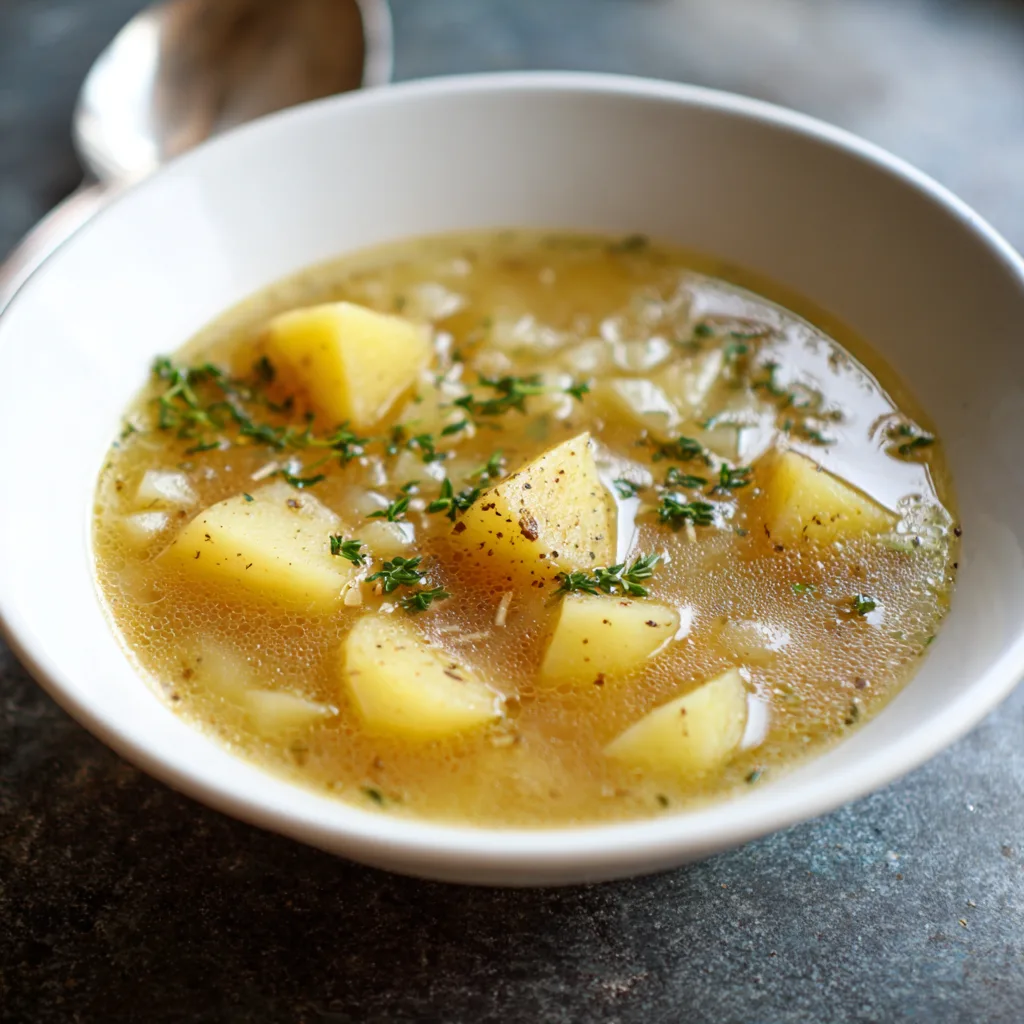What Is One-Pot Potato Broth?
One-pot potato broth is a simple, nourishing liquid made by simmering chopped potatoes with aromatics and seasonings in a single pot. This cooking method draws out the flavor and nutrients from the potatoes into the liquid, creating a light, comforting base. Unlike a hearty potato soup, this broth has a thinner consistency and fewer solid ingredients. It’s designed for sipping, using in recipes, or serving as a detoxifying, easy-to-digest meal. With just a handful of basic ingredients and one cooking vessel, you get warmth, nourishment, and convenience in every ladle.
Why Make It in One Pot?
Using one pot simplifies the entire cooking process. You cut down on clean-up, save time, and concentrate flavors as everything cooks together. Fewer tools and fewer steps mean less stress in the kitchen. As the potatoes and seasonings simmer, their flavors blend smoothly into the broth, resulting in a rich, balanced taste. Making it in one pot also helps preserve nutrients that may be lost when ingredients are transferred or cooked separately. Whether you’re busy or just want to eat cleaner, this method delivers both ease and flavor.
Health & Nutrition Benefits of Potato Broth
Potatoes are packed with vitamin C, potassium, and B vitamins, all of which contribute to immune support and energy production. When simmered, these nutrients infuse into the broth, creating a light and nourishing drink. One-pot potato broth is naturally hydrating and gentle on the stomach, making it ideal for those recovering from illness or following a clean-eating plan. It suits vegetarian and gluten-free diets and can be easily customized for vegan preferences. This broth also supports digestion, especially when enjoyed warm and lightly seasoned.
Base Ingredients for the Broth
The heart of one-pot potato broth lies in its simplicity, and that starts with the right potatoes. Yukon Gold potatoes bring a creamy texture and mild flavor, while Russet potatoes offer higher starch content that helps naturally thicken the broth. Both varieties release their essence during simmering, making the liquid rich without needing thickeners.
Choosing the right liquid base is equally important. You can use water for a clean, neutral flavor or go with vegetable or chicken broth for added depth. Vegetable broth keeps the dish vegetarian-friendly while adding umami. Chicken broth lends a more savory taste and is ideal if you’re not avoiding animal products. The potatoes soak up whichever base you choose, so select according to your flavor goals and dietary needs.
Flavoring Agents for Depth and Aroma
To create a broth that feels full-bodied without being heavy, aromatic vegetables are essential. Start with chopped onions, which build a sweet, savory foundation. Garlic adds a punch of warmth and richness, while leeks bring a subtle, earthy flavor. When sautéed gently before adding the potatoes and liquid, these aromatics release natural sugars and oils that elevate the entire dish.
Layer in herbs and spices to enhance complexity. Thyme offers a woody, slightly minty flavor that pairs well with potatoes. Oregano contributes mild bitterness, which balances starchy sweetness. Add fresh parsley at the end to brighten the broth and introduce a fresh, herbal note. Use dried herbs if fresh ones aren’t available, but adjust the quantity to avoid overpowering the broth.
Optional Enrichments & Creative Variations
Want a richer, more indulgent version? Add dairy. A splash of cream or milk creates a creamy broth with a silkier texture. A small pat of butter melted into the pot adds depth and a luxurious mouthfeel without changing the broth’s core simplicity.
To build flavor and texture, include mix-ins. Crispy bacon or vegan bacon bits add smokiness. Diced carrots or celery provide natural sweetness and crunch. Green peas introduce a pop of color and subtle earthiness. These additions allow you to shift the broth toward a heartier soup or leave it light and clear, depending on your preference.
You can customize the final texture by blending part of the broth for a creamy feel or straining it for a clearer, sipping-friendly broth. Whether you’re looking for comfort in a cup or a flavorful foundation for other recipes, these variations make one-pot potato broth endlessly adaptable. Choose ingredients that match your dietary needs and your mood—this broth can flex with both.
Dietary Considerations for Potato Broth
One-pot potato broth is naturally flexible and suits a wide range of dietary needs. It’s vegetarian by default, and you can easily make it vegan by skipping any dairy or animal-based broth. Replace butter with olive oil or vegan margarine. For a gluten-free version, simply avoid bouillon cubes or broth concentrates that contain wheat-derived thickeners.
Vegetable broth keeps the recipe plant-based without sacrificing flavor. To add richness without dairy, use unsweetened plant-based milk like oat or almond. Even coconut milk can work for a slightly sweet twist. These easy swaps allow the broth to fit most modern dietary lifestyles while keeping the ingredient list clean and nourishing.
Serving Occasions & Best Pairings
Potato broth is a go-to for gentle nourishment. It’s perfect for detox days, digestive resets, or anyone recovering from illness. Because it’s light and hydrating, it’s great as a sipping broth in the morning or before bed. Warm and comforting, it soothes without feeling heavy.
You can also use this broth as a base for other soups and stews. Add lentils, grains, or more vegetables to build on the flavor. For a satisfying meal, serve it alongside crusty bread, fresh sandwiches, or leafy green salads. This broth complements both hearty and light fare, making it a versatile dish for every season.
Preparation Steps
Start by washing your potatoes thoroughly to remove any dirt or debris. Peel them if you prefer a smoother broth, or leave the skins on for extra nutrients and a more rustic flavor. Dice the potatoes into uniform chunks—about 1 inch in size. This helps them cook evenly and release starch gradually into the broth. Smaller pieces break down more easily, producing a thicker consistency if left unstrained. Use starchy potatoes like Russet for a silky result, or Yukon Gold for a richer, buttery taste.
Next, focus on your aromatics and herbs. Chop the onion finely so it softens quickly when sautéed. Mince the garlic to release its full flavor. If you’re using leeks, slice them thin and rinse thoroughly to remove grit. Prepare fresh herbs like parsley or thyme by removing any tough stems. Having everything ready before cooking ensures a smooth and efficient process.
Cooking Process
Step 1: Sauté Aromatics for Flavor Depth
Heat a tablespoon of butter or olive oil in a large pot over medium heat. Once hot, add the chopped onions and stir until they begin to soften—about 3 to 5 minutes. Then, add the garlic and cook for another minute, just until fragrant. If you’re using leeks, toss them in with the onions. This step builds the flavor base of the broth and enhances the aroma. Avoid browning the garlic, as it can turn bitter and overpower the delicate potato flavor.
Step 2: Add Potatoes and Herbs
Add the diced potatoes directly into the pot with your sautéed aromatics. Stir to coat the potatoes in the oil and flavor base. Add your chosen herbs at this stage—dried thyme, a bay leaf, or oregano work well. Stir everything gently for one to two minutes. This gives the herbs a head start in infusing the broth while allowing the potatoes to begin releasing starch.
Step 3: Simmer with Liquid Until Tender
Pour in your broth or water, making sure the liquid fully covers the potatoes. Bring it to a boil, then immediately reduce the heat to low. Let the mixture simmer uncovered for about 20 to 25 minutes. The potatoes should be fork-tender, not falling apart. Stir occasionally to prevent sticking. If you’re using low-sodium broth or water, you can start seasoning lightly during this stage, then adjust later. A longer simmer allows the flavors to blend while drawing out nutrients from the potatoes and herbs.
Step 4: Blend or Strain, Depending on Desired Texture
Once the potatoes are soft, decide on your final texture. For a smooth, creamy broth, use an immersion blender to blend directly in the pot. Alternatively, transfer to a stand blender in batches, then return it to the pot. If you want a clear broth, strain out the solids using a fine mesh sieve or cheesecloth. This results in a light, golden liquid perfect for sipping or as a base for other dishes. Both methods work beautifully—choose based on your goal.
Step 5: Final Seasoning and Finishing Touches
Taste the broth once your texture is set. Add salt and pepper to taste. If needed, a splash of lemon juice can brighten the flavor. A drizzle of olive oil or a pat of butter can enhance richness. For a fresh finish, stir in chopped parsley or a pinch of paprika. If you’ve chosen to leave it chunky, check that all vegetables are evenly soft. Adjust the thickness by adding a little more broth or water if needed. Then serve hot or store for later.
Common Mistakes & Troubleshooting
Avoiding a cloudy broth: If you want a clear liquid, avoid stirring too much while simmering and don’t overcook the potatoes. Stirring releases more starch, making the broth cloudy or thick.
Managing creamy vs. thin textures: Blend only part of the batch for a semi-creamy result. For a thinner broth, strain or avoid blending completely.
Dealing with over-thickening: If the broth reduces too much or becomes too thick, stir in more hot water or broth a little at a time until you reach the desired consistency.
Reheating without separation: When reheating creamy versions, use low heat and stir occasionally to maintain a smooth consistency. Avoid boiling again, as it may cause separation or loss of flavor.
Flavor Variations to Elevate Your Broth
One-pot potato broth adapts easily to different tastes. To create a loaded-style version, stir in crispy bacon, shredded cheese, or a spoonful of sour cream. These additions transform it into a richer, more comforting dish—perfect for a cozy evening meal.
For a brighter twist, try a tomato-potato broth. Simply add crushed tomatoes or tomato paste during simmering. This creates a tangy, slightly sweet variation that tastes similar to a rustic tomato soup. Pair it with basil or Italian seasoning for an herbal edge.
If you prefer hands-off cooking, the Instant Pot makes preparation even easier. Use the sauté function to cook aromatics, then pressure cook for 8 to 10 minutes. Quick-release and blend or strain as needed. This method locks in flavor while saving time.
For a vegan version, use plant-based milk such as oat or almond to add creaminess. Swap bacon for veggie crumbles or vegan bacon bits. Finish with fresh herbs like dill, chives, or parsley for added color and brightness.
Storage Tips for Maximum Freshness
Store leftover potato broth in the refrigerator for up to 4 to 5 days. Allow the broth to cool completely before transferring it into containers. Always use airtight jars or lids to prevent odors from affecting flavor.
For longer storage, freeze the broth in portioned batches. Silicone molds or freezer-safe glass containers work best. Leave some space at the top to allow for expansion. When ready to use, thaw overnight in the fridge or gently reheat over low heat.
Glass containers are ideal over plastic because they resist staining and hold heat better. They’re also non-reactive, keeping your broth tasting pure even after several days.
How to Use Leftover Broth Creatively
Don’t let a single drop go to waste—leftover potato broth is incredibly versatile. Use it as a soup base by adding beans, greens, or grains. It makes an excellent starter for lentil stew or creamy vegetable chowder.
Cook grains like rice, quinoa, or bulgur in the broth instead of water for extra flavor. Use it to thin sauces or gravies while adding depth. You can even use it as the cooking liquid for risotto, replacing traditional stock with a lighter, veggie-forward alternative.
This broth is more than just a side—it’s a foundation for smart, flavorful cooking.
One-Pot Potato Broth – Simple, Comforting & Budget-Friendly

A light, nourishing potato broth made entirely in one pot—easy to prepare, comforting, and versatile for sipping or as a cooking base.
Ingredients
- 1 lb Yukon Gold potatoes, peeled and diced
- 1 medium onion, chopped
- 2 garlic cloves, minced
- 4 cups vegetable or chicken broth
- 1 tbsp olive oil or butter
- 1 tsp dried thyme (or 1 sprig fresh thyme)
- Salt and pepper, to taste
- Optional: ¼ cup diced carrot, celery, or vegan bacon
Instructions
Notes
Frequently Asked Questions
What is potato broth good for?
Potato broth is ideal for hydration, gentle digestion, and detox support. It provides vitamins and minerals in a comforting, easy-to-consume form. You can sip it on its own or use it as a base for other recipes.
Can I make potato broth in one pot?
Yes, and that’s one of its biggest advantages. A one-pot method keeps preparation simple, locks in flavor, and reduces clean-up. It’s fast, efficient, and ideal for busy kitchens or batch cooking.
Is potato broth healthy?
Absolutely. Potatoes are rich in potassium, vitamin C, and fiber. When simmered, these nutrients infuse into the broth. It’s low in fat and can be customized for nearly any diet.
How long does homemade broth last?
Refrigerated in an airtight container, potato broth stays fresh for 4 to 5 days. For longer storage, freeze it in portions and use within three months for best flavor.




